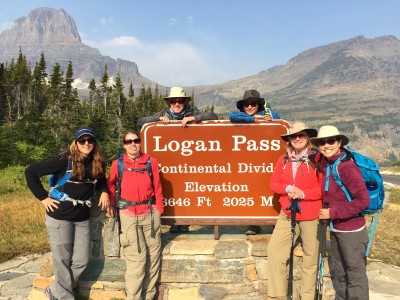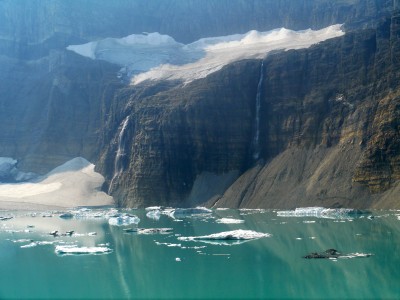Climate Hike Meets Climate Change
Team Emmett Hikes Glacier National Park with Climate Ride
 Team Emmett — a group of seven women raising money for the Emmett Institute on Climate Change and the Environment — just returned from an incredible trip to Glacier National Park sponsored by the fabulous Climate Ride (Ted posted here about his experience on Climate Ride last year). We hiked to a glacial lake and an historic chalet; saw grizzlies, black bears, mountain goats, big horned sheep and moose; slept in teepees on the Blackfeet Reservation; met an incredible group of people dedicated to improving our environment; and raised almost $35,000, which the fabulous and generous Dan and Rae Emmett will match. We also saw and experienced the effects of climate change firsthand.
Team Emmett — a group of seven women raising money for the Emmett Institute on Climate Change and the Environment — just returned from an incredible trip to Glacier National Park sponsored by the fabulous Climate Ride (Ted posted here about his experience on Climate Ride last year). We hiked to a glacial lake and an historic chalet; saw grizzlies, black bears, mountain goats, big horned sheep and moose; slept in teepees on the Blackfeet Reservation; met an incredible group of people dedicated to improving our environment; and raised almost $35,000, which the fabulous and generous Dan and Rae Emmett will match. We also saw and experienced the effects of climate change firsthand.
First, a bit of background. Team Emmett includes UCLA Law’s retired Dean of Students Liz Cheadle, Emmett Institute Co-Executive Director Cara Horowitz, UCLA Law’s Assistant Dean of Career Services Beth Moeller, our Associate Dean of External Affairs Lindsey Williams, friend and Caldwell Leslie partner Jeanne Fugate, UCLA Law alum Shirley Sanematsu, Senior Attorney at the Western Center on Law and Poverty and me. We’ve spent the last few months hiking around southern California in preparation for four days of hiking in Glacier. The Climate Hike is part of Climate Ride, an amazing organization that organizes and staffs bike rides and hikes around the country. Participants designate environmental organizations as beneficiaries and Climate Ride does the rest of the work (except for the riding, hiking and camping!) The organization has raised almost $1 million over the past several years through its events. Friends and supporters of the Emmett Institute have now participated in two Climate Rides and the Glacier Climate Hike.
The trip to Glacier was incredible. The park is, of course, one of the gems of the National Park System. It contains alpine meadows and lakes, historic chalets and lodges, almost 800 miles of hiking trails, more than a million acres of forest, more than 70 species, gorgeous rivers and, of course, glaciers. It’s hard to describe the physical beauty and the variety of resources the park contains. We hiked the famous highline and trekked to Grinnell Glacier, for me the most beautiful spot we encountered.

We were led by a team of extraordinary guides who know the park inside and out. Not only did they guide us on our hikes but they also transported our luggage from campsite to campsite, cooked us breakfast, lunch and dinner, tended our wounds (Lindsey Williams cut her foot on a hike and got immediate medical attention from one of the guides), bandaged our blisters, entertained us with stories about the history of the park, and rowed us down the middle fork of the Flathead River. Climate Ride works in conjunction with Glacier Guides to staff the Glacier Hike and the staff from each group are nothing short of extraordinary.
We also hiked, camped and ate with a wonderful group of participants representing a great group of environmental organizations, from the National Parks Conservation Association to the Alliance for the Great Lakes to the Nature Conservancy.
And we encountered the effects of climate change. Big time. The park was surrounded by wildfires and inundated with smoke from the worst wildfire year in history in Washington State. At times the smoke was so thick we wore face masks to avoid it. On Friday the smoke was so thick it felt apocalyptic. Highway 2, the southern boundary of the Park, closed along with Amtrak because of the Sheep Fire just south of the park.

Then there’s the longer term effects of climate change. In 1850, the park had 150 documented glaciers. By 2010 that number had fallen to 25 and predictions are that many of the remaining glaciers will be gone by 2030 or even sooner — many are disappearing faster than even the models predict. Glaciers are not just beautiful but a crucial part of the park’s ecosystem, providing a reservoir for water storage. Without that water storage, stream temperatures and stream flow are likely to change, with higher temperatures and lower stream flow having a devastating impact on numerous species of aquatic animals and the land-based animals that depend on them.
Glacier is, in many ways, the proverbial canary in the coal mine for climate change. The effects are happening now, they’re visible and they’re frightening. Time to start planning your trip now before the glaciers melt.
Reader Comments
2 Replies to “Climate Hike Meets Climate Change”
Comments are closed.






Last month, we took a vacation to Florida for climate change. We went to the beach and watched the sea level, it was very profound for us to experience this first-hand. We observed how sea level extends to the horizon and this deeply affected us and I believe that we now have a better understanding of how climate affects everyone. I am so thankful for this opportunity to share with others.
Thank you Team Emmett for putting your talents to work on behalf of helping to save our planet! You are awesome!!